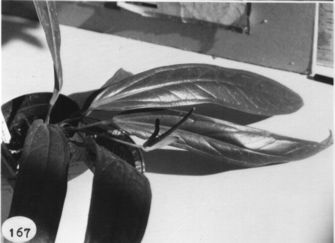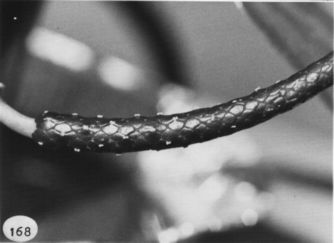




Anthurium wedelianum ssp. viridispadix Croat, ssp. nov.
TYPE: Panama. Code: on Atlantic slope near the Continental Divide along lumbering road N of El Copé, 9.4 km above El Copé (2.2 km N of sawmill), 8°42'N, 80°37'W, 750-900 m, Croat 44640 (MO 2509620, holotype; K, PMA, US, isotypes; Live at MO).
Anthurium wedelianum ssp. viridispadix differt spadice atrovirentibus crescens altitudibus celsibus.
Epiphyte; stems less than 10 cm long, ca. 1 cm diam.; internodes short; leaf scars moderately conspicuous, 7-8 mm wide; roots green, moderately few, short, 2.3 mm diam.; cataphylls moderately thin, green, acuminate at apex, soon weathering to thin, pale fibers (at least at the base).
LEAVES spreading; petioles 2-8 cm long, subterete, sharply to bluntly sulcate, sometimes with a faint medial rib, one-eighth to one-fourth as long as the blades; geniculum ca. 1.5 cm long, usually more sharply sulcate than the petiole; blades moderately thin, oblong-oblanceolate, gradually acuminate and sharply downtumed at apex, acute at base, 21-35 cm long, 4.5-5.5 cm wide, broadest well above the middle; both surfaces semiglossy, epunctate, lower surface only slightly paler; midrib weakly raised in a moderately deep valley above, acutely raised below; primary lateral veins 4÷7 per side, departing the midrib at 30÷45° angle, straight to weakly curved to the collective vein, raised below, drying weakly raised above; tertiary veins prominulous beneath; collective vein usually arising from the base, rarely from one of the lower primary lateral veins.
INFLORESCENCE shorter than leaves; peduncle subterete with several weak, purplish ribs, sometimes spotted with purple, 8-10(-25) cm long, ca. 3 mm diam., longer than the petioles; spathe moderately thin, green, ovate-lanceolate to oblong-lanceolate, acuminate at apex, rounded at base, 4-6 cm long, 0.7-1.7 cm wide, broadest below the middle, inserted at a 20° angle on peduncle; stipe 9-10 mm long (to 2.5 cm in fruit), 2-3 mm diam., green tinged with parple at base; spadix dark green, moderately upexed to the apex, (4-)5.5-11 cm long. 6 mm di÷L near the base, 3 mm diam. near the apex: flowers rhombic, 5-5.5 mm long, 3.7-4.5 mm «ide,lfee sides jaggedly sigmoid; 2-3 flowers visible÷the principal spiral; tepals glossy, the lateral fefk 5-6-sided, 3-3.5 mm wide, broadly rounded lo obtusely angular on the inner margin; pistil not usually apparent before anthesis of stamens. eventually weakly emergent, paler green than the tepals with purplish dots; stigma broadly ovate: stamens emerging promptly from the base, the lateral pair often extending ca. three-fourths the length of the spadix before the alternates emerge, the alternates emerging in a prompt sequence, persisting in a tight, contiguous cluster just above the edge of the tepals; anthers white, 0.3-0.4 mm long, 0.5 mm wide; thecae ovoid, slightly divaricate; pollen orange fading to tan.
INFRUCTESCENCE to ca. 14 cm long; berries subglobose, dark violet purple, ca. 7 mm long; mesocarp densely imbedded with short raphide cells; seeds 2, ca. 4 mm long, 2.8 mm diam., 1.5 mm thick. Figs. 167 and 168.
Anthurium wedelianum ssp. viridispadix is endemic to Panama on the Atlantic slope and known only from Veraguas, Code, and Col—n Provinces at 500 to 800 m in tropical wet and premontane rain forest life zones.
This subspecies is distinguished from the typical subspecies by having a green spadix (thus the name viridispadix) that lacks raphide cells in the tepals. In addition, the latter is known from below 300 m elevation in premontane wet forest.
 |
 |
Map of Mesoamerican specimens with coordinates
Panama Bocas del Toro: 825 m, 8.45N 82.15W, 25 Oct. 1985, Gordon McPherson
7347 (MO).
Panama Bocas del Toro: 350-500 m, 8.15N 82.08W, 10 March 1986, Gordon
McPherson 8754 (MO).
Panama CoclŽ: 750-900 m,, 20 Jan. 1978, Thomas B. Croat 44640 (MO).